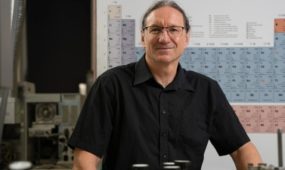Sand lab breaks ground in oil and gas industry
Education
A HI-TECH lab to test silica sand and ceramics for their fracking ability is helping a South Australian company break new ground in the mining industry.

Sign up to receive notifications about new stories in this category.
Thank you for subscribing to story notifications.
LAB SA has opened a new proppant testing lab in Adelaide to service the emerging unconventional oil and gas industry. It is one of the only independent labs of its kind in Australia.
The global proppant industry is expected to grow to more than $19 billion a year by 2019.
Proppants are made of high quality silica sand or ceramics and are used in fracking fluids. Fracking involves explosions deep in the well to open fractures.
The fluid is then injected at high pressure into the oil and gas well fractures. As the fractures close, the proppant “props” them open for a period of time to allow the flow of oil or gas through the fractures into the well.
LAB SA general manager Andrew Attard said the company had helped develop “shockcrete” for mining companies at Olympic Dam in South Australia and Broken Hill. But he said the proppant test lab would allow it to expand into other parts of the mining industry.
The new lab, which received $100,000 in grant funding from the South Australian Government’s Mining and Petroleum Services Centre of Excellence, has so far tested silica sands for their proppant suitability for mining companies in the United States and the Australian states of Queensland, Western Australia and the Northern Territory.
“Now that we’ve got our foot in the mining resources area we can use our experience in soils, geotechnical, concrete and raw materials testing to move into other areas,” Attard said.
“It’s something our clients have wanted and have actively asked us to pursue.
“Hopefully there’s some movement into Asia with some independent verification.
“People are just starting to hear about what we do and what we can offer … everyone’s heard about the magic proppants – they’re a highly sought after commodity so a lot of companies are sending in materials saying ‘can we use this or use that’.”
Attard said different silica properties such as size of sand grain and crush capabilities were suited to different wells depending on their depth and pressure.
“The right choice of proppant is absolutely critical,” he said.
“It’s not a new technology but it’s a technology that’s making companies reassess the viability of older wells … to see if they can reinvigorate them to get more output from them.”
Attard said South Australian silica sand was of a high quality but more needed to be discovered and companies were still learning about what processes were needed to clean it before it could be used as a proppant.
“There’s no reason why they can’t be used anywhere in the world,” he said.
“We are close to the local suppliers and we’ve got a unique understanding of local products so we can get testing results done in a matter of days rather than weeks and that gives us about a 40-50 per cent reduction in testing costs.
“Because of our independence and our ability to work across the three areas of soils, quarry materials and concrete we’ve got a good chance to make an impact in quite a diverse range of areas in the mining and resources sector. It’s one of our key strategic goals now to make the most of this impetus we’ve got from this new proppant lab.”
According to US-based global market research and consulting company MarketsandMarkets, the North American region dominates the proppant market because of its growing demand for fracturing oil and gas wells, followed by the Asia Pacific. Sand is the most commonly used of the three proppants available – sand, ceramic, and resin coated – due to its lower price.
The global proppant industry is expected to grow to more than $19 billion a year by 2019.
South Australian Mineral Resources and Energy Minister Tom Koutsantonis said LAB SA had seized the opportunity to become an integral part of a local supply chain and develop technology from scratch after an inquiry from a sand supplier.
LAB SA Managing Director Trevor Kokkinakis said South Australia had always been a leader in support services and technology, particularly to the resources sector.
“LAB SA has shown how small business can utilise government support to turn ideas into world class services,” he said.
Jump to next article



